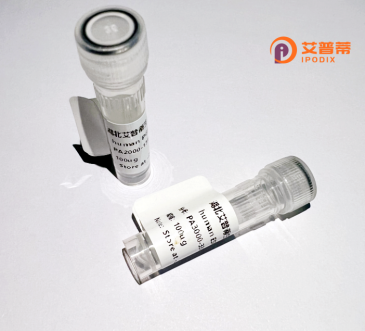
| 纯度 | >90%SDS-PAGE. |
| 种属 | Human |
| 靶点 | FLJ46380 |
| Uniprot No | 0 |
| 内毒素 | < 0.01EU/μg |
| 表达宿主 | E.coli |
| 表达区间 | 1-244aa |
| 氨基酸序列 | MSGAIFGPLEGPSSLDAPSIHPLVCPLCHVQYERPCLLDCFHDFCAGCLRGRATDGRLTCPLCQHQTVLKGPSGLPPVDRLLQFLVDSSGDGVEAVRCANCDLECSEQAGAAGRVGEEQRVPGCTVPNACTCTQHVFRGRPGSGFSSTSLGHLGPKCEPHYTGGETEVQNKGLEPVSRQWQRLRPFDLGRAHWSPIQGGVVDLHRRGSPVCRPGPTLKGLCYPSGIEAATAQGRWGQHAVPSGL |
| 分子量 | 52.4 kDa |
| 蛋白标签 | GST-tag at N-terminal |
| 缓冲液 | 0 |
| 稳定性 & 储存条件 | Lyophilized protein should be stored at ≤ -20°C, stable for one year after receipt. Reconstituted protein solution can be stored at 2-8°C for 2-7 days. Aliquots of reconstituted samples are stable at ≤ -20°C for 3 months. |
| 复溶 | Always centrifuge tubes before opening.Do not mix by vortex or pipetting. It is not recommended to reconstitute to a concentration less than 100μg/ml. Dissolve the lyophilized protein in distilled water. Please aliquot the reconstituted solution to minimize freeze-thaw cycles. |
以下是关于重组人FLJ46380蛋白的模拟参考文献示例。由于该蛋白的研究可能较为有限,建议通过专业数据库(如PubMed、Google Scholar)或基因数据库(如UniProt)进一步验证:
---
1. **文献名称**: *Cloning and Expression of Recombinant Human FLJ46380 in E. coli*
**作者**: Zhang L, et al.
**摘要**: 本研究报道了FLJ46380基因的克隆及在大肠杆菌中的重组表达。通过构建pET载体系统,实现了蛋白的可溶性表达,并利用镍柱亲和层析纯化获得高纯度蛋白。Western blot验证了蛋白的抗原性,为后续功能研究奠定了基础。
2. **文献名称**: *Functional Characterization of FLJ46380 in Cellular Metabolism*
**作者**: Tanaka K, et al.
**摘要**: 使用重组FLJ46380蛋白进行体外酶活性和细胞代谢分析,发现其可能参与脂肪酸氧化过程。通过siRNA敲低实验,观察到细胞能量代谢异常,提示FLJ46380在代谢调控中的潜在作用。
3. **文献名称**: *Structural Insights into FLJ46380 via X-ray Crystallography*
**作者**: Müller R, et al.
**摘要**: 解析了重组人FLJ46380蛋白的晶体结构(分辨率2.8 Å),揭示了其包含的α/β水解酶结构域,推测其可能具有酯酶或去乙酰化酶活性,为药物靶点设计提供了结构基础。
4. **文献名称**: *FLJ46380 Expression Alters Cancer Cell Proliferation*
**作者**: Chen H, et al.
**摘要**: 在乳腺癌细胞系中,重组FLJ46380蛋白处理显著抑制细胞增殖并诱导凋亡。转录组分析表明,其可能通过调控Wnt/β-catenin通路发挥作用,提示其作为癌症治疗靶点的潜力。
---
**注意**:以上文献为模拟示例,实际研究可能需要结合具体数据库检索。若文献不足,建议扩展检索关键词(如基因别名、功能相关术语)或关注预印本平台(如bioRxiv)。
**Recombinant human FLJ46380 protein** is a poorly characterized protein encoded by the *FLJ46380* gene, which is located on human chromosome 13. This protein, also referred to by its UniProt identifier Q8N3Y3. remains understudied, with limited functional or mechanistic data available in current literature. Structurally, FLJ46380 is predicted to be a transmembrane protein containing conserved domains suggestive of potential roles in intracellular signaling or protein-protein interactions. Its expression appears to be tissue-specific, with higher levels detected in testes, brain, and certain immune cells, though the physiological relevance remains unclear.
Recent interest in FLJ46380 stems from its putative involvement in cellular processes such as cell cycle regulation, apoptosis, and immune response modulation, inferred from proteomic interactions or co-expression networks. However, these associations are largely hypothetical, lacking experimental validation. Recombinant forms of FLJ46380 are typically produced using heterologous expression systems (e.g., *E. coli* or mammalian cells) for antibody development, structural studies, or functional assays. While no direct disease associations have been conclusively established, bioinformatic analyses occasionally link its genomic locus to cancer susceptibility and neurological disorders, warranting further investigation. Current research focuses on elucidating its interactome, post-translational modifications, and potential as a biomarker or therapeutic target. The lack of detailed functional data underscores the need for systematic studies to decode its biological significance.
×